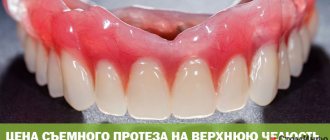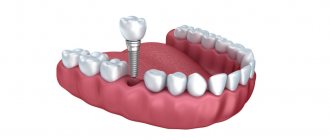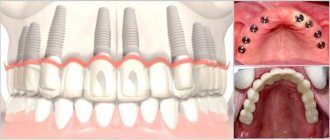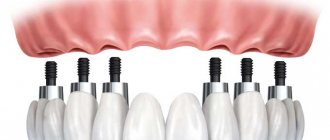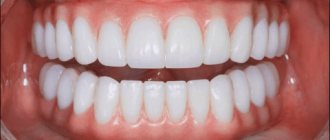Modern dentistry = dental implantation
In Russia, the first research in the field of implantology was carried out in the 80s by Professor O.N. Harsh. Despite the fact that he is a pioneer in domestic implantology, his extremely unsuccessful attempts to install implants led to the formation of a negative attitude towards dental implantation in our country for a long time. Only in the 90s did the first training centers begin to appear (still in most Russian medical universities there is no such discipline as implantology) and representative offices of distributors of implant manufacturing companies. However, the question “dental prosthetics or implantation?” for modern Russian dentistry has already been decided, and it has been decided unambiguously. Since Ingvar Branemark installed the first implant, technology has developed to such a level that it can solve even the problem of complete absence of teeth in the shortest possible time and with maximum comfort for patients.
Modern methods of dental implantation
Today, all over the world, and in Russia too, medical science is making leaps and bounds, and dentistry is one of its fastest-growing areas. Such outdated implantation methods as subperiosteal, intramucosal, transosseous and many others are already a thing of the past; neither plate nor endodontic implants are used anymore, anesthesia completely relieves physical discomfort, and modern implantation methods make it possible to reduce the time spent on preparing and performing the operation, as well as on the healing of soft tissues and the implantation of implants.
Contraindications
There are few contraindications to non-surgical implantation. These include severe mental disorders, decompensated cardiovascular and endocrine diseases, and pathologies of the blood coagulation system. Also, a relative contraindication is inflammatory processes in the oral cavity of various etiologies, so implantation can be carried out after a full course of treatment. Non-surgical implantation is not recommended for patients with thinning soft gum tissue (less than 2 millimeters).
Implantation without gum incision
One of the most popular modern methods of dental implantation is the installation of implants without an incision in the gums (this method is also called express implantation). Instead of an incision, in this case, a so-called puncture is most often used: in order to get to the bone tissue of the jaw, the doctor does not make several incisions in the soft tissue of the gums, does not fold back the flap, and does not apply sutures upon completion. This became possible thanks to the latest developments in modern dentistry, for example, special drills that can penetrate soft tissue with minimal trauma, as well as the invention of the laser. The least bloodless and least traumatic type of implantation is laser implantation, which has a number of advantages:
- there is no need to apply stitches, since all dissected tissues are instantly cauterized;
- the use of a laser is an additional antiseptic;
- the healing period occurs even faster;
- installation of one implant lasts on average 10 – 15 minutes;
- the implant takes root better, since the risk of inflammation of the soft tissue surrounding it is practically reduced to zero due to the absence of stitches.
Structure and types of implants
A dental implant (implant) is a structure that imitates a tooth root. It is formed from a biologically inert material: titanium alloy or zirconium dioxide. Externally, the design resembles a screw that is inserted into the bone tissue. Subsequently, an abutment is fixed on it - an intermediate link between the artificial root and the prosthesis itself.
Implant models vary in length, diameter, pitch and thread shape, so the dentist can select an option based on the individual characteristics of the patient’s jaw structure. A separate group includes mini-implants (designed to fix individual areas of the dentition during orthodontic treatment), as well as zygomatic options that are screwed into the patient’s zygomatic bone. Similar designs are used in people with thinned bone tissue due to prolonged absence of teeth.
Today, dental clinics have products from different manufacturers, of which the most popular are:
- Nobel Biocare (Russia);
- Osstem (South Korea);
- Alpha Bio (Israel);
- Astra Tech (Sweden).
They provide structures of various shapes, as well as all the necessary accessories and additional components for effective prosthetics.
Implantation with immediate loading
Many patients, especially those who had implantation or learned about it 10-15 years ago, today are in no hurry to resort to this type of dental prosthetics, because they believe that it will take a very long time and will be associated with long-term discomfort, including psychological. Simply put, no one wants to walk around with “holes” instead of teeth and spend several hours in the dentist’s chair for many days. If you belong to this category of people, then we have good news for you: medicine, including dentistry, does not stand still! Today, thanks to the development of modern methods of one-stage implantation, the installation of one implant lasts no more than half an hour, and then only in the most severe cases, and up to ten dental implants can be installed during one visit to the doctor, and it is absolutely painless.
As for the break between the installation of the titanium root and the artificial tooth itself (crown), in most cases it can be reduced to several minutes. Modern dental implantation most often involves immediate loading of the implant with a temporary crown. This is done for aesthetic reasons so that the patient does not experience psychological discomfort during the period of osseointegration, which can take from several weeks to six months. At this time, it is impossible to install a full-fledged permanent crown on the implant, be it metal-ceramic or ceramic. A technology for the manufacture and installation of temporary crowns on implants was developed especially for this period. They are machined from a special hypoallergenic plastic, which in terms of aesthetic characteristics does not differ from dental ceramics and in the same way fully imitates the patient’s natural tooth, primarily due to the ability to select the color. This reduces the number of stages of dental implantation.
As for strength, then, of course, in this parameter plastic is inferior to both natural teeth and the materials from which permanent crowns are made. However, it is durable enough to last for several months and even be used for chewing. The price of temporary crowns is an order of magnitude, or even two, lower than that of permanent crowns, which is logical.
Metal-ceramic prosthesis
After the implants have healed to the bone, a permanent fixed prosthesis can be installed. One of the most popular options is a metal-ceramic structure with a metal base coated with a layer of ceramic. As a rule, such a prosthesis is more convenient than a removable structure, because imitates the presence of “native” teeth with greater accuracy. Fixed prostheses are devoid of plastic elements, which reduces their size and increases ergonomics. Gum subsidence is successfully hidden with ceramics of a suitable color.
Advantages of a fixed metal-ceramic prosthesis on implants:
- Convenience.
There is no need to take off/put on the prosthesis. Chewing functions are restored completely, the palate and gums are open without affecting taste sensitivity. - Strength.
Metal ceramics are particularly resistant to deformation due to the chromium-cobalt alloy, which is resistant to mechanical damage. It is thanks to this that metal-ceramic dentures last a long time, maintaining their performance characteristics to the end. - Aesthetics.
The properties of metal ceramics make it possible to perfectly imitate soft and hard tissues of the oral cavity. An experienced specialist can masterfully work out the color transitions so that the artificial gum will not be noticeable from the outside even upon careful examination.
Implantation on the day of removal
Another modern method of dental implantation is one-stage implantation. This term refers to the installation of a dental implant, abutment and temporary crown immediately after tooth extraction, that is, during one visit to the doctor. With all the preparations, such a procedure will take at most an hour.
The essence of this technique is that the latest technologies and materials used in dentistry make it possible not to wait for complete healing of the jaw bone and gums after tooth extraction to begin implantation. Today, in most cases where it is impossible to save a tooth, it is possible to immediately install an implant in the cavity created as a result of extraction. But immediate implantation is carried out only in the absence of a deep inflammatory process.
This type of implantation reduces the traumatic nature of the procedure, the time spent on it, speeds up the healing period, and also prevents psychological discomfort for the patient, since he does not need to walk around with a “hole” instead of a tooth.
Timing of prosthetics
The doctor can announce the approximate timing of prosthetics at the preparatory stage of implantation, when implants are being selected and the surgical technique is determined. It has been proven that the stability of the implant decreases for some time after implantation, and then gradually increases, reaching the required values in 3 months in the lower jaw and in six months in the upper jaw. Prosthetics are carried out within these periods, which is what the classical technique is designed for.
The first two weeks and the next 2 months are the most critical period after surgery to install implants. At this time, the artificial root does not have much stability, because osseous integration has just begun. Installing crowns at this time is the most risky for the patient. However, if implantation is carried out with immediate loading with the installation of a prosthesis within 1-7 days after the implants are inserted, there is no harm to the jaw and the implants themselves.
Interestingly, it is easier to predict the results of a single-stage load of the entire jaw than a single implant. This is due to the peculiarities of biomechanics: a non-removable design combines implants into one system, minimizing the impact of lateral forces that can displace a single implant with a crown.
However, care should be taken after installing the prosthesis not to subject it to unnecessary stress. For the first 2 months, it is advisable to give up hard, solid foods, giving preference to soft, crushed foods. In the third month, you can start eating as usual, but cutting food into small pieces. Habitual eating is possible starting from 4 months, if we are talking about implantation of the lower jaw. In the upper jaw, as mentioned above, bone integration takes at least six months; accordingly, during this period the prosthesis should be protected from increased chewing load.
Implantation using a surgical template
Modern dental implantation no longer involves such unpleasant aspects as prolonged psychological discomfort for the patient, a high likelihood of complications, risks, unknowns and much more, which, unfortunately, the pioneers of this area of dental treatment had to face. Today, cases of implant rejection are 5–2%, installation of one implant lasts on average 15 minutes, and the risk of medical error is minimized.
Perhaps the pinnacle of modern dental implantation can be considered the so-called surgical template for implantation. This term means precise and high-tech planning of the operation, eliminating even the minimal risk of medical error or difficulties during implantation. This technique is especially in demand in cases where the installation of several implants or the restoration of an entire row of teeth is required.
How is a surgical template created and what is it for? On the first visit, the patient undergoes a panoramic x-ray of the dentition - an orthopantomogram. Next, for several days the patient goes about his business, while his attending physician performs painstaking work - high-precision planning of the future operation. In a special laboratory, based on the patient’s orthopantomogram, a computer 3D model of the jaw is made, on which the implantologist calculates all options, assesses the proximity of neighboring roots, nerves, canals, etc. and draws up a plan for installing implants, taking into account the angles of inclination and all related factors. Roughly speaking, the doctor is already performing a full-fledged operation, but only on a virtual model.
Next, using this model, which is a surgical template, the dental technician makes plaster casts, and from them - temporary crowns that will be installed on the patient’s implants on the day of the operation.
Thus, thanks to the use of a surgical template, the doctor can calculate everything in advance and even “practice”, which, firstly, negates almost all risks, and secondly, saves the patient’s time and nerves.
